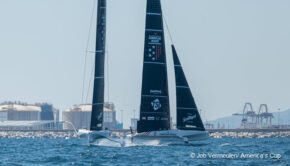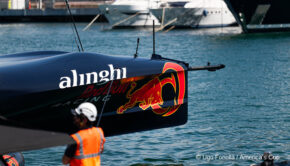Twin-skin mainsail hits superstardom
Published on March 6th, 2021
by Rebecca Hayter, North Sails NEWS
The twin-skin mainsail, which has hit superstardom thanks to the AC75, is a surprising rediscovery of a patent developed by LF Herreshoff in 1927; LF Herreshoff was the son of Nathanael Herreshoff and, despite the famous father, his designs never won an America’s Cup.
The sail configuration has solved a challenge of foiling the AC75 that designers faced in 2017: how to lift 6.5-tonnes of hull, sails, crew, and foiling arms from the water into flight– without the cumbersome fixed, solid wing.
However, we are not sure if Herreshoff would recognize the double-skinned mainsail beyond the basic concept: two mainsails set on the straight edge of a D-section mast. In both the 1929 original design and the 2021 version, each has its own controls such as halyards, outhauls, cunninghams, and mainsheet so the windward mainsail and leeward mainsail can be independently trimmed from each other.
For the 36th America’s Cup, black, boldly emblazoned, double-skinned and deck sweeper North 3Di sails are hoisted up a rotating D-shaped mast to power Emirates Team New Zealand, Luna Rossa Prada Pirelli, and INEOS TEAM UK.
We sat down with JB Braun, director of Design and Engineering at North Sails, to learn even more about how the twin skin mainsail works together with the new boats. Braun, with six America’s Cups under his belt, says the AC75’s sails, rig, foils, and deck shape comprise an aerodynamic package in ways never seen before. A package which North Sails refers to as the “engine above the deck.”
Thanks to advances in sailmaking, specifically North 3Di technology, and complex mainsheet control systems, the mainsail trimmers can alter the shape of the upper sections and lower sections of the mainsails. By trimming the leeward sail to a greater depth than the windward sail, the trimmer can form a powerful, vertical foil to generate power for lift-off – something that may not have been possible with a single mainsail– nor a solid wing.
While sailing, the double-skinned mainsails can be trimmed to morph and move through the constantly changing demands the boat needs for straight-line speed, quick take-offs, and slick maneuvers. “The apparent wind angles are so small, we’re entering a whole new realm of sail design,” JB said. “Those sails need to be super flat, with low twist, to have the maximum efficiency at the higher speeds.”
That high level of versatility is a big part of why the double-skinned mainsail got the job, but it also demands precise and coordinated skills of the sailing crew. Never before have sailors trimmed to speeds so fast and loads so vast, all in a foiling boat in which a sudden lapse in the breeze can go to splashdown, race over.
“I think the biggest learning curve is going to happen with how the boats and sails and crews work together and manage the process of sailing the boats faster,” JB said.
With a team of grinders powering all those slick maneuvers, precise trimming becomes even more important. JB explained the leeward mainsail surface carries a higher load than the windward side. If the main trimmer knows they need to save the grinders’ energy for a tacking duel, the trimmers might then trim the mainsail for the most efficient use of power.
With speeds of more than 50 knots, it seems like too much speed is not a “thing.” While the AC75s have risen above the water to escape hydrodynamic drag, there still is the drag and turbulence created by the movement of air over the boat and sails. As a result, this has brought another unusual way to go faster: smaller sails.
“On a normal boat you might think, ‘The only way I can go faster is to get more wind,’” said JB. “But on these boats, you go faster by reducing drag. The air starts to be a high percentage of the total drag so that’s why these boats tend to shift the size of the jib down rather quickly. [Outside of the Cup] sailors want to have the biggest sail that they can possibly get away with, but on AC75s, with the speed dictated by the apparent wind, you want the smallest sail you can get away with.”
So what does this mean for the teams and for North Sails? Continuous development with sail design for the “magic formula.” Like we saw recently on the Hauraki Gulf, teams are making sure no idea is left untried.
“Pre-Christmas there was a lot of light air sailing, which made it hard to foil, and I think that made for a bunch of changes in sail design. You can change the sails rather quickly so if the sails weren’t doing what you wanted, you could re-engineer them and design with a specific goal.”
The rules allow 10 pairs of mainsails per team, plus a certain percentage of re-cuts. “We are so automated in not only the design and the feedback loop but the CFD (computational fluid dynamics) and FEA (finite element analysis), that we can understand a problem and then have an automated system that can reliably produce what we simulated. So you have confidence that you’re going to get what you designed.”
To sign up for North Sails NEWS, click here.
More information:
• America’s Cup format, standings, and how to watch online: click here.
• Complete America’s Cup coverage: click here
• Additional America’s Cup information: click here









 We’ll keep your information safe.
We’ll keep your information safe.